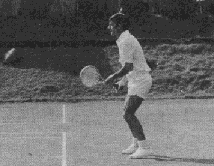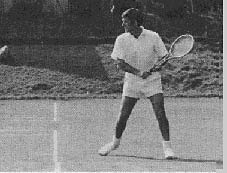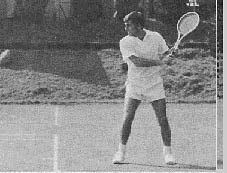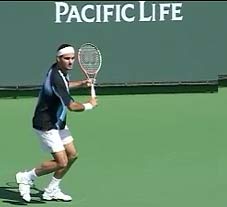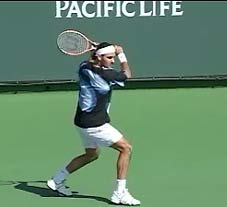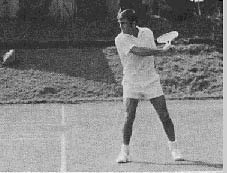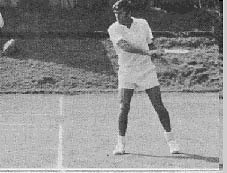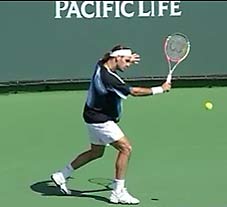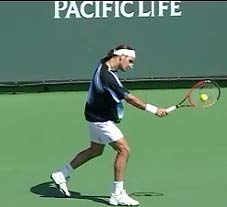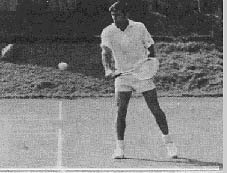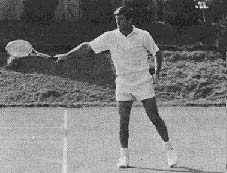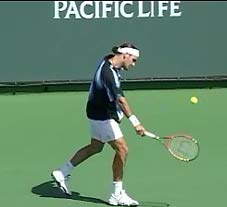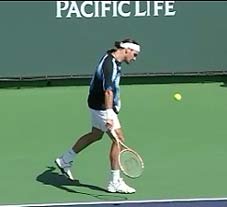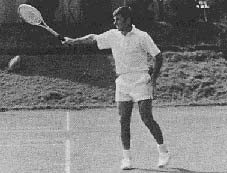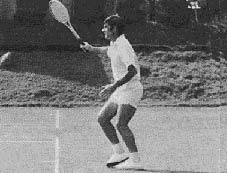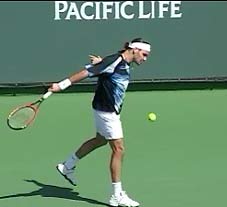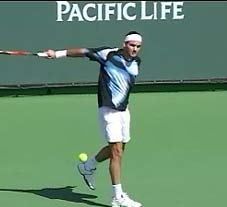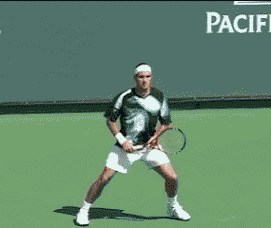|
TennisOne Lessons
Ken Rosewall to Roger Federer A Comparison of the Underspin Backhand By Sergio Cruz The underspin backhand has been seen in many forms. Patrick Rafter's chip and charge, Pete Sampras' from the backcourt or on the approach, even Andy Roddick has now added an underspin backhand to his backcourt arsenal. Underspin is produced with a slight to severe downward hitting action, and a racquet face that is either slightly or severely open. The backspin will cause the ball to rise, as opposed to topspin which causes the ball to dip. Therefore, the underspin when attacking is hit with less spin so it won't sail out of court, and when defending is played more with finesse so this sailing is controlled. In the modern game the passing shots are nearly always hit with topspin so the diving ball makes volleying more difficult. In the "old days" the prevalence of the underspin backhand was a boon to net rushers as those underspin passes dipped less, and it was Rod Laver who unleashed the topspin backhand (which interestingly Sampras studied as a youngster). The photos that follow contrast a relatively flat underspin drive with a heavily underspin backhand slice. The racquet paths are dramatically different, the intention of the shots are different, and the position of the head from Rosewall to Federer is different. But now I digress. In 1988 Jim Courier and I were entering an indoor facility where players were preparing for the Detroit ATP tournament. We could hear the resonant sounds of tennis balls being struck on dozens of courts but, we could not see the courts nor the players yet. A particularly clean sounding stroke attracted my attention and I said to Jim, "There is someone here that hits the ball cleaner then anyone else!"! We went to the court where this special resonance emanated from, and to our surprise...that someone was Ken Rosewall.
Ken was warming-up for a senior event with Bill Scanlon a former top 10 and main event participant who would lose to a young Pete Sampras in a close 3 set match. Many of the top-ten in the world in 1988 were warming-up as well, but it was Rosewall's percussions that were unique. Rosewall, one of the game's all time greats, was a left handed player taught to play with the right hand. At only 5-foot-7-inches and 135lbs, many thought him too small. He proved them wrong! Rosewall won 18 major titles in a career spanning 25 years. Rosewall's serve was only average, his volley on the other hand was excellent, he played with pinpoint accuracy. His backhand was truly outstanding, and he was known for his quickness, anticipation and balance. The only grand slam Rosewall failed to win was Wimbledon. Nevertheless he reached the wimbledon final 4 times in a 20 year time span. In 1974, at age 40, he lost a one sided final to Jimmy Connors. At age 44 he concluded the 1977 season still ranked in the top 15 in the world, having won 2 of 24 tournaments and finishing with a match record of 44-23. Truly an amazing performance! The Underspin Backhand Professionals at the highest level produce near carbon copies of their strokes when hitting the ball in nearly identical situations. Therefore, I assume that the following strokes are not random accidents but actual stroking habits these players repeat again and again. Using images of Ken Rosewall, lets examine how he executed his slice backhand compared to that of Roger Federer, currently one of today's top players who also utilizes a slice backhand in competition.
Photo 1 - Rosewall (above right) and Federer have prepared and in both cases, note how their head and eyes are perfectly aligned to the ball. Photo 2- While both players execute the unit turn early, Federer creates greater shoulder rotation with a significant closed stance. This exaggerated turn along with a higher racquet position and a more extreme backswing will result in greater potential spin and angular rotation through the ball. Rosewall sets up with a much shorter and compact backswing. Note how he keeps his head directed forward with his eyes clearly centered on the incoming ball.
Photos 3 & 4 - Rosewall lowers his swing to a more horizontal swing path while flattening the racquet to lie parallel with the ground. This pattern is not only fairly unique to Rosewall, but indicates a much flatter slice than that which Federer will hit. This can be further identified in the racquet's position immediately following contact While the action of the racquet "rolling" to contact can increase the speed of the racquet (and subsequent pace of the shot), this action must be timed perfectly to create a repetitive and consistent contact point. While Rosewall mastered this timing, few top players today (if any!) utilize such technique in their backhand slice. Rosewall drives through the desired trajectory on a fairly flat plane. Federer's racquet continues down at a significant angle indicating significant slice spin.
Photos 5 & 6 - Both players remain sideways through contact. Federer allows his racquet head to drop as a result of the severe downward slice he has applied to the ball. Rosewall, in contrast, maintains a traditional horizontal swing plane and subsequent continuation of the stroke with his racquet head remaining above the wrist. (Today, many top players still execute backhand slice strokes in this manner.) Note Rosewall's balance which is impeccable, driving his full body weight into the ball.
Photos 7 & 8 - Federer utilizes the off-arm to maintain his sideways position through contact. The force of his stroke opens Federer up after contact and contributes to the recovery stage of the stroke and his body position. Rosewall uses a more relaxed follow-through with less of an aggressive attack on the ball than Federer. A note on the eyes - when playing the ball out in front like Rosewall, the player has the opponent and the court within their peripheral vision - that is they can see where they are aiming and what the opponent might be doing prior to the hit. In contrast, Federer has his head at the side, the court and opponent are not in his peripheral vision at all. You the reader may stop at this point to reflect on how you use your head and eyes at contact, or how you notice other players use their head and eyes. Federer uses almost a golf like technique, where nothing moves or looks up at contact. Rosewall does not move his head or eyes either, but in his case the court is definitely within his field of vision. I believe you are better served with the rosewall method, where contact, your head, and your eyes are all out in front, even though one cannot fault the accuracy produced by the federer method. Finally a note on the racquet and forearm. Rosewall takes the racquet back relatively level, but with the face initially pointing up (photo 4). In order to hit the ball from this position he will have to roll his arm and forearm to square the racquet. This was effective, but equally it is tricky, for if you roll the arm too soon the ball goes into the net, too late and the ball sails. Federer on the other hand swings without a pronounced forearm roll, and indeed from photo 3 of Roger we see the strings facing the ball, so there would be no need to roll the forearm. In some ways Rosewall's drive was unique, as we do not see players in the modern game with the racquet in a similar position. You may try and experiment with this as follows - this Rosewall drive is somehow the opposite of the arm action on the serve - that is, the arm and forearm rolls in at contact (often called pronation though I do not like that term) and on this backhand the arm and forearm rolls out at contact (aka supination). The rolling hit takes perfect timing but when timed well, pays interesting dividends. Evolution of the Game In many respects the game of tennis has changed in the past 50 years. The role of the slice in the modern game differs greatly than in the Rosewall era. The slice to day is used as a defensive shot, when stretched out of position, as a holding shot from the baseline as Federer uses it, as a chip and charge approach shot, ala Rafter and other attacking players, and as a blocking shot on return of serve. But the slice is rarely, if ever, used as an offensive drive the way Rosewall used it.
Rosewall drove the ball to the corners, heavily, and with pinpoint accuracy. His classic backhand derived its potency from weight and accuracy, forcing opponents into short or weak replies. His stroke was flatter and often deeper but he had limited options when pinned in the backhand corner. Drive down the line or play a delicate chip short and crosscourt. Rosewall could not come over the ball. Today's players are armed with weapons of mass destruction and can pass with topspin from any position on the court. Interestingly, when defending, Roger's swooping wicked underspin may be a more effective reply than the pinpoint drive, it floats that one moment longer for additional recovery time and it skids low to combat the brutal semiwestern forehands of his opponents (which were relatively nonexistent in Rosewall's day). This low bounce helps blunt any countering offense. Further, in Rosewall's day the ball generally arrived in a flatter arc, enabling him to drive through this flat arc with a relatively flat swing. Nowadays when Federer defends, he is typically underspinning against a rising and heavily topspinning ball, and this underspin stroke exactly parallels the trajectory of the incoming ball. But this is to be debated only (and often) when players get together to discuss whether or in fact how the game has changed (and continues to change) at the professional level. From a fans point of view, Federer is a delight to watch and may very well be the most, complete player on the ATP tour since Pete Sampras retired. Serve and volley, chip and charge, winners, aces, in all he is simply superlative and the very best tennis has to offer! Today's professional game is played at an unbelievable level - with incredible court coverage and blinding racquet speed. But, as Roger Federer so eloquently demonstrates, the single mode games of his opponents are extremely vulnerable. Pete sampras dominated his peers in similar fashion and at one point he was so dominant that over 5000 ATP points separated him from the number 2 player. I believe that few coaches took notice of this all court style. Coaches, teachers and players should dedicate themselves to play the all court game. This will contribute to better player development and a much more attractive game. Your comments are welcome. Let us know what you think about Sergio Cruz's article by emailing us here at TennisOne . |

